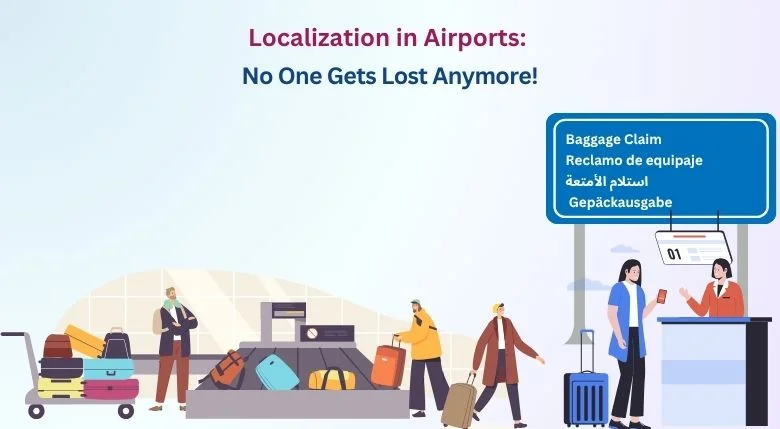
Ever had the adrenaline rush at the airport when your gate changes at the last minute?
You hustle through, heart racing, only to reach there just in time—relieved and a little proud of your instincts. And finally, thankful that the gate change announcement was made in English. But what if it hadn’t? It serves as a reminder of the vital role languages play in these high-stakes moments.
Airports aren’t just large buildings meant for travel; they are also a hub of global cultural meeting points for travelers from diverse linguistic backgrounds. But there’s a catch: Despite all the screens, announcements, and signage, most of the time, confusion arises due to language barriers. And that’s why localization is important to bring down these barriers.
In this blog, we will explore the vital role that localization services play in enabling airports to operate efficiently.
What Is Localization?
Localization is a process that extends beyond translation, focusing on adapting airport content—such as signage, announcements, and documents—to suit the language, culture, and context of a target audience.
For instance, in airports in Spain, signage for baggage belts, customs, and washrooms is written in Spanish, English, Arabic, French, and Italian. This is done to avoid confusion among non-Spanish-speaking travelers.
Do Airports Really Need Localization?
This is how localization helps airports.
Multilingual Signage and Navigation
Imagine finding baggage claim after a long flight, especially when the instructions at the airport are written in a different language. Airport content localization ensures that passengers of all language backgrounds can move confidently through terminals and gates.
The best-case example for this is the Changi Airport in Singapore. As one of the most modern airports in the world, it excels in localizing signage, announcements, and digital content in multiple global languages like English, Mandarin, Malay, Tamil, and Arabic. Furthermore, the airport also offers multilingual staff and immigration-certified translators to ensure smooth communication at customs.
Announcements and Real-Time Updates
As mentioned in the beginning, a sudden gate change or flight delay announcement in an unknown language can cause heaps of trouble for travelers. With proper localization, these vital time-sensitive updates are delivered in several languages to ensure most passengers understand what’s being said.
According to the International Air Transport Association (IATA), 65% of global travelers feel safer when they receive travel updates in their native languages.
LOOKING TO TWEAK YOUR CONTENT ACCORDING TO THE TARGET REGIONS?
Contact us today for top-tier multilingual localization services!
Legal and Immigration Support
A vital part of any foreign travel is to get past immigration as smoothly as possible. With bundles of custom declarations, visa forms, and permits, airports start to feel like a bureaucratic nightmare. However, with assistance from multilingual immigration-certified translators, essential documents can be interpreted accurately, avoiding delays and confusion. Any airport that partners with a professional document translation service can also convert high-stakes licenses and forms to negate errors and boost operational efficiency.
Immigration translation services are useful in other scenarios, too. Do you wish to know more about them? Check out this blog: Certified Translations: A Helping Hand in Immigration Processes!
Cultural Sensitivity and Comfort
Airport localization also needs to consider the tone, customs, cultures, traditions, and gestures of the target region to avoid being disrespectful to the travelers.
For instance, when you land in an airport in an exotic foreign country and receive a welcome greeting in your native language, it is taken as a well-mannered gesture. This is because of the localization that translates messages and ensures it does not offend any travelers.
Localization and document translation are also used in duty-free retail shops and food courts of the airports.
All these efforts and steps are taken only to achieve one goal: the complete comfort of the visiting passengers.
Accessibility for All
Several travelers have special needs, be it age or physical impairments. For them, localized audio, Braille signage, and multilingual help kiosks are offered to enhance inclusivity in the airport.
Want a First-Class Localization Experience?
In reality, no announcements and digital screens in the airport can make up for a message that travelers simply cannot understand.
From signage to safety and customs to coffee shops, localization is essential. They not only ensure clarity in communication but also enhance operations by reducing delays.
But where to find such a localization service that can help airports to the fullest?
Somya Translators, a leading ISO 17100:2015-certified translation and localization company, helps airports and other stakeholders with exceptional multilingual support. Whether it is by providing an immigration-certified translator or an educational translator for students, we are your reliable partners in making airport communication smoother.
With Somya Translators, an airport can efficiently speak to the world—clearly, accurately, and culturally!
Contact us today to grab a free quote!

